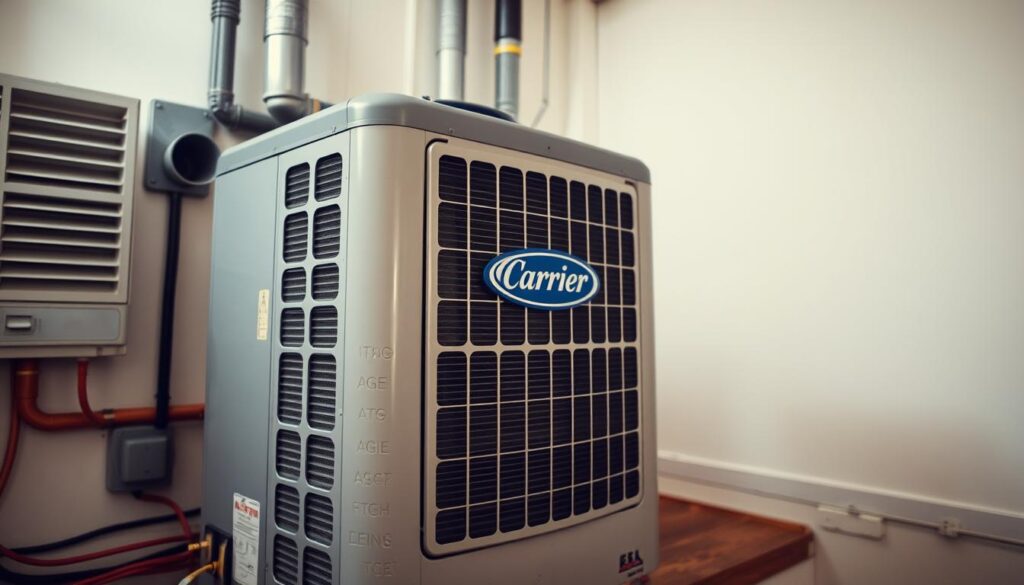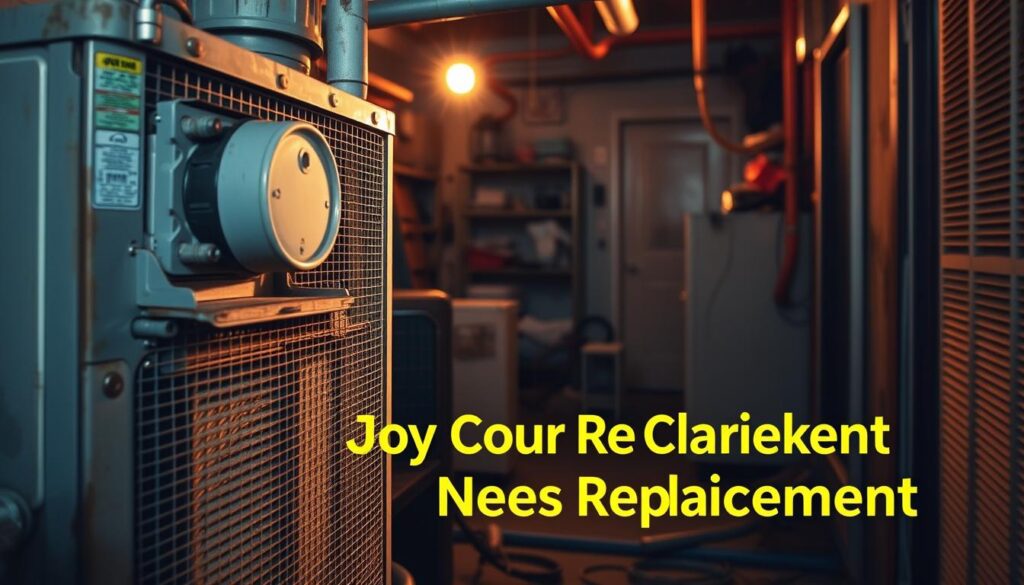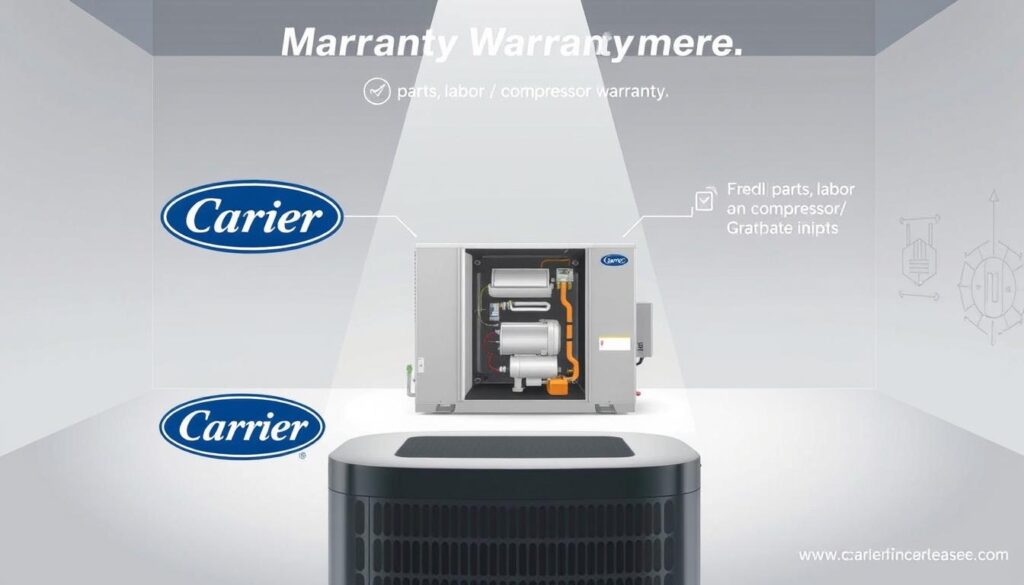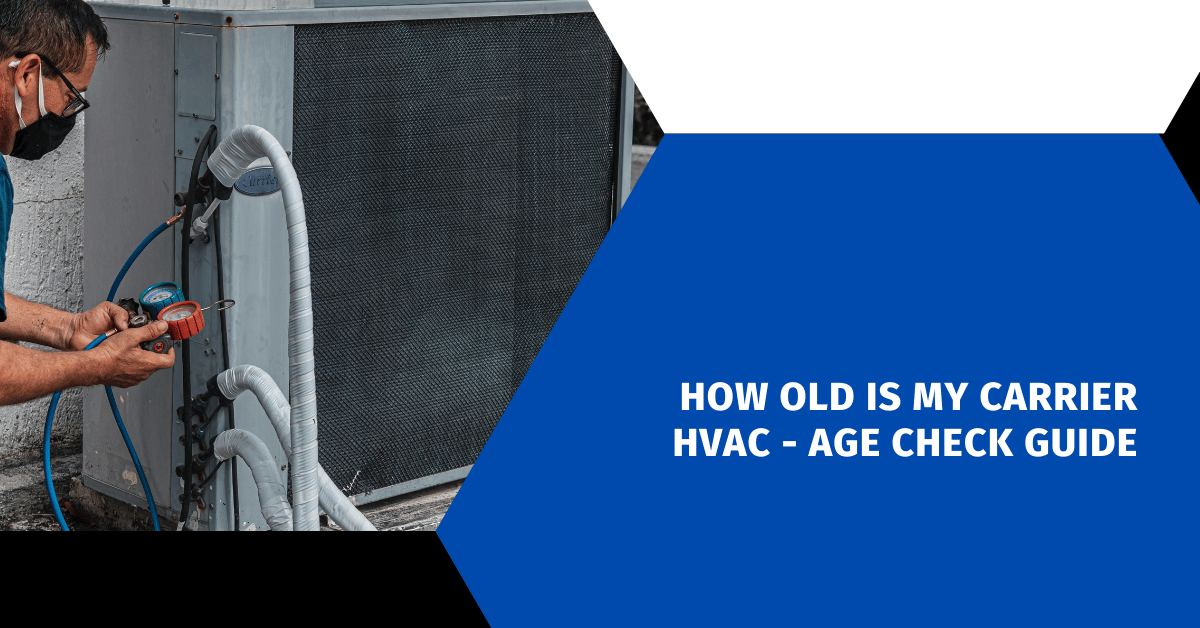Affiliate Disclosure
HVAC Guide Guys is a participant in the Amazon Services LLC Associates Program, an affiliate advertising program designed to provide a means for sites to earn advertising fees by advertising and linking to Amazon.
How Old Is My Carrier HVAC? Ever thought knowing your Carrier HVAC system’s age could save you thousands? It’s more important than you might think.

Willis Carrier invented modern air conditioning in 1902. Knowing your Carrier HVAC’s age is key to keeping your home comfortable.
Your HVAC’s age affects its energy use and repair costs. Knowing its age helps you make smart choices about upkeep and upgrades.
Key Takeaways
- Age determines your HVAC system’s performance and efficiency
- Serial numbers are key to finding out system age
- Regular maintenance can make your system last longer
- Older systems might need more repairs
- Knowing age helps with budgeting
Table of Contents
Understanding Your Carrier HVAC System Age and Its Importance
Knowing your Carrier HVAC system’s age is key for keeping your home comfortable and efficient. Your aging HVAC systems are vital for your home’s performance. They can also affect your wallet and safety.
As HVAC systems get older, they use more energy. They usually last between 10-20 years, depending on how well they’re taken care of. Knowing your system’s age helps you spot problems early and plan ahead.
Impact on Energy Efficiency and Performance
Older HVAC systems use more energy, which means higher bills. Here are some things to think about:
- They cool and heat less well
- They use more energy
- They’re less efficient overall
Safety Considerations for Aging Systems
Old HVAC systems can be risky. They might have:
- Potential gas leaks in older furnaces
- Worn-out electrical connections
- Less safety against carbon monoxide
Financial Planning Benefits
Tracking your HVAC system’s age helps with budgeting. Smart homeowners can:
- Save for future replacements
- Get regular maintenance
- Avoid costly repairs
Tip: Regular professional checks can tell you how your system is doing and how long it will last.
Explore Our HVAC Shop
Looking for top-rated HVAC tools, parts, and accessories? Visit our shop and find the perfect solution for your needs.
Visit the ShopHow Old Is My Carrier HVAC: Locating the Serial Number
Knowing how old your Carrier HVAC unit is important. It helps you understand its performance and when it might need maintenance. The serial number is key to finding out how old your unit is.
Finding the serial number might seem hard, but it’s usually in a few places:
- Inside the furnace cabinet door
- Near the blower compartment
- On the exterior control panel
- Behind the outdoor condensing unit
To find your serial number, carefully open the access panel. Look for a metal plate with numbers and letters. This plate has important info about when your HVAC system was made.
“The serial number is your HVAC system’s birth certificate” – HVAC Professional
Carrier models can have different places for the serial number. So, take your time to check the unit well. If you’re not sure, check your owner’s manual or call a Carrier technician for help.
The serial number is very important. It shows how old your equipment is. It also helps with warranty, repairs, and when you might need a new one.
Decoding Carrier Serial Number Formats
Knowing how old your Carrier HVAC system is is key for keeping it running well. An hvac age calculator can be helpful. But first, you need to figure out what your serial number means. Carrier has changed its serial number formats many times, so it’s important to know how to read them.
The lifespan of a Carrier HVAC system depends on how well it’s taken care of and what type it is. Knowing exactly how old your system is helps you decide when to fix it or replace it.
Four Numbers and Letter Format
This classic format gives you important info about when your system was made. Here’s how to understand it:
- The first two digits show the week it was made
- The next two digits tell you the year
- The letter at the end shows where it was made
Nine-Character Numerical Format
Carrier later introduced a more detailed nine-digit system. It gives more info about when and where it was made:
- The first digit tells you the product type
- The next two digits are the year
- The following digits show the week and more specific details
Eight-Character Format for US and Canada
This format is for systems in North America. It makes it easier to find out when it was made:
| Position | Information | Example |
|---|---|---|
| 1-2 digits | Year of manufacture | 19 |
| 3-4 digits | Week of manufacture | 42 |
| 5-8 digits | Specific unit identifier | 0001 |
By knowing these serial number formats, you can quickly find out how old your Carrier HVAC system is. This helps you make smart choices about its upkeep and when it might need to be replaced.
Explore Our HVAC Shop
Looking for top-rated HVAC tools, parts, and accessories? Visit our shop and find the perfect solution for your needs.
Visit the ShopUnderstanding Pre-1980 Carrier Serial Numbers
Finding out how old older Carrier HVAC systems are can be tough for homeowners. Before 1980, Carrier had special serial number formats. These are different from today’s ways of identifying systems. It’s key to understand these old serial numbers to figure out your HVAC system’s age and when it might need to be replaced.
Carrier had different serial number systems for systems in the U.S. and Canada back then. Knowing how to read these numbers is important. It helps you guess how long your system will last and make smart choices about upkeep.
- U.S. Systems: Seven-character all-numeric serial numbers
- Canadian Systems: Five-character all-numeric serial numbers
To find out how old your pre-1980 Carrier HVAC system is, look for the serial number on the unit’s data plate. Each digit in these older serial numbers tells you something about when it was made.
Pro Tip: If you’re having trouble reading an old serial number, reach out to a Carrier expert. They can help figure out when your system was made.
Old HVAC systems might not work as well as newer ones. Even if some old systems last a long time, most from before 1980 will need to be replaced. This is to save on energy costs and improve efficiency.
Average Lifespan of Carrier HVAC Systems
Knowing how long an HVAC system lasts is key for homeowners. Carrier systems are built to last, but their lifespan depends on several factors.
The lifespan of your Carrier HVAC system can change based on how well you maintain it, how often you use it, and your local environment. Understanding this helps you plan for repairs or replacements.
Furnace Life Expectancy
Home furnaces usually last 15-20 years. Their lifespan can be influenced by:
- Regular maintenance
- Quality of initial installation
- How often you use it
- Indoor air quality
Air Conditioning Unit Longevity
Air conditioning units usually last 10-15 years. Keeping them in good shape and fixing them on time can help them last longer.
| HVAC Component | Typical Lifespan | Key Maintenance Factors |
|---|---|---|
| Furnace | 15-20 years | Annual professional inspections |
| Air Conditioning Unit | 10-15 years | Regular filter replacement |
| Heat Pump | 10-15 years | Seasonal cleaning |
Factors Affecting System Lifespan
Several important factors can affect how long your HVAC system lasts:
- Maintenance frequency
- Installation quality
- Local climate conditions
- Usage patterns
- Indoor air quality
Regular maintenance can greatly extend your Carrier HVAC system’s life. It might even add years to its operation.
Explore Our HVAC Shop
Looking for top-rated HVAC tools, parts, and accessories? Visit our shop and find the perfect solution for your needs.
Visit the ShopKey Signs Your Carrier HVAC Needs Replacement
Knowing when to replace your HVAC system can save you a lot of money. It also helps avoid sudden breakdowns. Carrier HVAC systems usually last a certain number of years. But, some signs show it’s time for a new one.

When your HVAC system starts to perform poorly, it’s a big sign. Here are some key signs that mean it might be time for a new system:
- Frequent and expensive repairs that cost more than half of a new system’s price
- Rooms in your home not staying at the same temperature
- Strange noises like grinding, squealing, or banging
- Energy bills going up, even with regular maintenance
“When repair costs start approaching the price of a new system, replacement becomes the smarter financial decision.” – HVAC Industry Expert
Look out for these red flags that could mean your system is failing:
| System Age | Replacement Likelihood |
|---|---|
| 10-15 years | High probability of significant performance decline |
| 15-20 years | Critical replacement recommended |
| 20+ years | Immediate replacement necessary |
Pro tip: Regular professional inspections can help you catch problems early, before they cost a lot.
Maintenance Tips to Extend Your HVAC System’s Life
Keeping your HVAC system in top shape is key. It’s a big investment that needs regular care. This ensures it works well and lasts longer.
Regular maintenance is vital for your Carrier HVAC system. It stops sudden failures and keeps it running efficiently.
Creating a Consistent Service Schedule
Having a set maintenance plan is essential. Here are some important steps:
- Schedule professional maintenance twice yearly
- Do monthly checks on your system
- Clean around your HVAC equipment
- Keep outdoor units clear of debris
Air Filter Replacement Guidelines
Air filters are very important. Dirty filters can make your system work harder. Here’s when to replace them:
- Check filters every month
- Change standard filters every 90 days
- Change them more often if you have pets or allergies
- Use filters made for your Carrier model
Professional Inspection Recommendations
While you can do some maintenance yourself, pro inspections are a must. They help find problems early and keep your system running right.
- Spot issues before they become big problems
- Do detailed system checks
- Adjust system parts for better performance
- Help your system use less energy
Regular maintenance can add years to your HVAC system’s life. It also saves you money over time.
Explore Our HVAC Shop
Looking for top-rated HVAC tools, parts, and accessories? Visit our shop and find the perfect solution for your needs.
Visit the ShopUnderstanding Carrier Warranty Coverage Based on Age

It’s important to know how old your Carrier HVAC unit is. This info helps you understand your warranty. Each part of your HVAC system has its own warranty period, tied to its age.
Carrier offers warranty coverage with rules based on your HVAC’s age. Most warranties include:
- Registered equipment gets longer coverage
- Parts warranties last 5-10 years
- Heat exchangers get extra protection
Your HVAC unit’s age affects its warranty terms. Carrier offers different protections based on when it was made and registered.
| HVAC Component | Standard Warranty | Extended Warranty Option |
|---|---|---|
| Compressor | 5-10 years | Up to 20 years |
| Parts | 5 years | 10 years |
| Heat Exchanger | 20 years | Lifetime limited |
Pro tip: Register your Carrier HVAC system within 60 days of installation to get the most warranty coverage.
“Warranty protection is your financial shield against unexpected HVAC repairs” – HVAC Industry Expert
To keep your warranty valid, schedule regular maintenance. Also, keep all service records. The age of your HVAC unit affects not just coverage but also repair or replacement options.
Making the Decision: Repair vs. Replace
Choosing between repairing or replacing your HVAC systems can be tough. The age of your HVAC systems is key in this decision. Older systems often cost more to fix as repair costs add up.
When looking at your HVAC systems, keep these points in mind:
- System age: Units over 10-15 years need more repairs
- Total repair costs vs. the cost of a new system
- Current energy efficiency rating
- How often the system breaks down
“If repair costs exceed 50% of a new system’s price, replacement is usually the smarter financial choice.” – HVAC Industry Expert
Smart homeowners should think about long-term costs. A system that needs constant fixes might seem cheaper at first. But, new systems can save you money on bills.
Important things to consider include:
- How well your system works now
- How much energy it uses
- Any tax credits for new systems
- What warranties cover
Talking to a professional HVAC technician can help. They can give advice based on your system’s condition and your home’s needs.
Explore Our HVAC Shop
Looking for top-rated HVAC tools, parts, and accessories? Visit our shop and find the perfect solution for your needs.
Visit the ShopEnergy Efficiency and Tax Credits for New Systems
Getting a new HVAC system can save you money in many ways. The government gives tax credits to homeowners who buy energy-saving heating and cooling systems.
Here are the current tax incentives for improving your HVAC system:
- 30% federal tax credit for ENERGY STAR® certified systems
- Maximum credit of $600 for qualifying furnaces
- Eligibility for systems with 97% annual fuel utilization efficiency (AFUE)
Modern Carrier HVAC systems use a lot less energy than old ones. By getting a new system, you can cut down on your monthly bills and help the environment.
Upgrading has many benefits:
- Improved energy efficiency
- Lower utility expenses
- Enhanced home comfort
- Potential tax savings
To get tax credits, your new HVAC must meet ENERGY STAR® standards. Talk to a professional HVAC technician to find the best system for your home.
Pro tip: Keep all receipts and installation records to claim your tax credits.
Conclusion
Knowing how old your Carrier HVAC system is is key to your home’s comfort and energy use. An HVAC age calculator and serial number decoding can tell you a lot. They show how well your system works, what maintenance it needs, and when it might need to be replaced.
By keeping track of your system’s age, you can save a lot of money and avoid sudden breakdowns. Knowing exactly how old it is lets you plan for upgrades, maintenance, and repairs. This way, you can avoid big problems before they happen.
Every Carrier HVAC system lasts differently, based on how well it’s taken care of, how often it’s used, and the environment it’s in. Regular checks by professionals, changing filters on time, and knowing what your system needs can make it last longer and work better.
With the knowledge from this guide, you’re ready to make smart choices about your home’s heating and cooling. Whether you’re looking at an older system or planning for new upgrades, you’ll know how to keep your home comfortable, energy-efficient, and worry-free.

